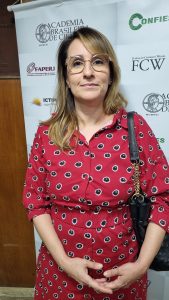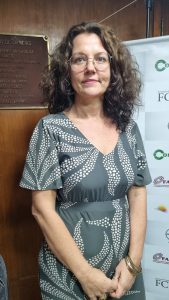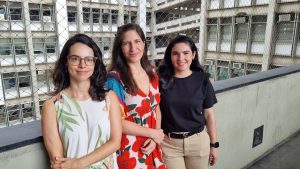Directorate of Communications Jörg
They represent 43.7% of researchers in Brazil, according to the National Council for Scientific and Technological Development (CNPq), but they still face many obstacles to establishing themselves and assuming leadership positions in the academic world. Brazilian women scientists need to deal with issues such as juggling research work, motherhood and family life, lack of confidence regarding their productive ability, and lack of incentives and recognition from institutions.
In the face of these historical difficulties, 13 researchers from the State University of Rio de Janeiro (Uerj) decided to present their projects and were included in the Program to Support Young Women Scientists Related to ICT in the State of Rio de Janeiro, a notification launched in 2023 by the Carlos Chagas Filho Foundation. To support research in the State of Rio de Janeiro (Faperj).
On International Women's Day this year, six of these young scientists at Orgean report on their experiences in academic life and detail the winning projects of the Faperj programme, in the fields of “Life Sciences”, “Exact, Technological and Interdisciplinary Sciences” and “Humanities”.
Innovative projects
Professor at the Institute of Biophysics, in the Laboratory of Mechanical Vibrations and Integrative Practices (LAVIMBI), at the Pique Carneiro University Clinic (PPC), that Danubia da cunha de sa caputo Develop your research. This is a project targeting autistic children aged 6 to 12 years, and through transcranial stimulation, it aims to develop skills in relation to the symptoms of autism spectrum disorder.
“We hope to improve these children's ability to understand, perceive and act as well as engage in language, which does not just involve speech. The age group of 6 to 12 years is the last chance for a child to develop, and it is very important to believe that these children have either not received good care, “Or even got it, but did not respond to the conventional treatments available. If no intervention is done during this period, they will continue into adolescence and adulthood carrying major issues of comorbidities and live a more dependent life. “This not only affects their lives, but also their Family life and society as a whole,” highlights Danubia, which intends to bring together participants on a large scale, in groups and associations of children with autism and also through SysReg.
researcher Maria das Grasas Coelho de Souzafrom the Laboratory of Clinical and Experimental Research in Vascular Biology, from the Department of Physiological Sciences at the Roberto Alcantara Gómez Institute of Biology (Ibrag), intends to develop her project on sickle cell disease, which, according to her, is neglected in Brazil.
“Because it affects black people, especially the poor, in our country, studies on the disease are still very rare. Activation of the thromboinflammatory pathway, the function of which we tried to uncover in this research, is the most important in this field today. I feel that we are at the forefront of sickle cell research, and above all, we are doing research on patients here in Brazil, for whom the data are still insufficient. We rely on volunteers from the Hematology Outpatient Clinic at Pedro Ernesto University Hospital to help us. “It is a great pleasure for me to also be able to help these people, who often suffer from thromboembolic events, reduced life expectancy and quality of life,” says Maria das Grasas.
the teacher Mayra kover sosay soares, from the Institute of Social Sciences, will develop quantitative research on families, domestic work, care and gender values in Brazil from an internationally comparative perspective. The project began its first phase in 2016 and now aims to clarify whether and how changes have occurred in gender values in the country.
“We went through a very specific decade, with a government in which the anti-gender agenda was very strong. And we had the pandemic. After this hurricane, how are gender values? Do Brazilians still believe that it does not matter if a child is raised by his father or mother? To what extent? “People agree with women working at home and taking care of the family, while men work outside the home? We want to ask how the epidemic affected family life in society. Initially, some indicators showed that men's productivity increased, while women's productivity decreased, due to their need to take care of their children.” says Mira.
Challenge of women in exact sciences
Among the recipients of the Faperj Prizes are three professors from the Uerj Institute of Physics: Leticia Faria Dominguez Balhares, Maria Clemencia Rosario Mora Herrera that it Paola de Oliveira Ribeiro Garlic. Researchers believe that the field of “exact, technological and multidisciplinary sciences” is particularly sensitive, because it is a field that is predominantly male. So much so that Faberge, aware of this disparity, in February launched the Girls and Women in Exact Sciences, Earth Sciences, Engineering and Computing programme, which aims to support women's participation in fields where traditionally males are frequently present. Applications are open until April 5.
Professor and researcher in the Department of Theoretical Physics, Leticia Palhares She says that she often participates in conferences where women represent between 1% and 3%. But for her, there is no greater challenge than reconciling motherhood with a scientific career. “For me, motherhood was a turning point. I entered the pandemic pregnant with a one-year-old, and it was very difficult. I found myself in a situation where I had to choose between devoting myself to my career or taking care of my children. I have never faced so many difficulties.” “In other situations, as a woman in physics. I felt motherhood in a more intense way. It's there in my mind: 'She was the mother.'” He reveals that this effect is so great that it is frightening.
Through the project “Confinement: Theory, Physics of Accelerators and Phases of Nuclear Matter,” Letizia tries to answer the question: What are we made of or what are things made of? “We know that things are made up of atoms, and inside them is the atomic nucleus. My study is trying to observe what is inside this nucleus. Can we find a fundamental piece that makes up everything else we observe, like a kind of Lego that everything is made of? At present we say that These little pieces are quarks, particles that we think are indivisible. I study the interaction between quarks to form the proton and the neutron. “We combine a very small world with a very active world, and to describe these interactions, we call it quantum field theory,” the researcher describes.
an experience Paula Alo, from the Department of Quantum Electronics, reveals gender inequality in the field of exact sciences. She is married to a physics professor in the same department, and often notices differences in treatment in academia. “We arrived at a conference and were immediately asked if I was his date. Or we would submit a project together and he would get it, but I don’t. That’s why a notice like this from Faberge is so important.”
Paula's project focuses on studying metallic materials and their intrinsic properties, which can be applied in alternative cooling. “The refrigerator coolant actually has a caloric effect, and it's a compressor that's pressing all the time and exchanging this heat: it takes it from here and dumps it outside. Our idea with i Calorics is to try to remove this slightly polluted gas, and put a solid in it, with the goal of Achieving advantages in terms of energy efficiency.
actually Maria Clemencia HerreraHe works from the Department of Nuclear and High Energy Physics on his project with experiments that detect, record and measure all the products of high-energy collisions between protons. “We are studying new technologies and silicon detectors to be able to prepare the detector sites for the next step of the LHC (particle accelerator), in which we will have many collisions per second. It will be High glossHigh speed, and many protons per second, so we need to have detectors ready to identify these protons quickly, with high accuracy, and with good response.
The researcher is Chilean, has lived in Brazil for 11 years, is married to a Brazilian physicist, and has two daughters. Through this profile, she mentioned that she has already gone through sensitive situations in her professional life. “It took me a while to see it, but I had bad experiences, of situations that could be considered harassment and discrimination, because I am a woman, a Latina, a mother, married to a colleague, and we are in the 21st century.” Maria Clemencia says. “It's getting better because women are speaking up more and more, and we're finding more and more openness to listening to criticism of systemic masculinity in physics,” he adds.
For the researcher, the biggest gain promoted by the Faberge program is the possibility of purchasing heavy equipment for the laboratory in which she works. “Winning the Women in Science competition was important because I will no longer be one of the signatories of a project that requires large equipment. Now I will be able to import, and the laboratory will be complete thanks to me! I feel amazing,” he celebrates.
Learn about the researchers at Organe and their winning projects:
Alene Patricia Flauzino Pires (Ecology): “Integrating biodiversity into the design of sustainable development solutions: a nexus approach”;
Annie Gomez Redig (Education): “Persons with intellectual disability and/or autism spectrum disorder: Representation in the transition to independent living”;
Daniela Regina Molinari (Chemical Engineering): “ECOSORVE – Re-evaluation of agro-industrial wastes for porous materials used in removing metals from polluted water”;
Danúbia da Cunha de Sá Caputo (Biophysics): “Effect of whole body vibration exercise and transcranial direct current stimulation on language, sleep quality, quality of life, psychomotor profile, sensory profile and mental health of 6- to 12-year-old children with autism spectrum disorder” ;
Eugenia Zandona (Ecology): “Miniature ecological bridges: how landscape elements influence the flow of energy, nutrients and greenhouse gases in small bodies of water”;
Fabricia Lima Fontes-Dantas (Pharmacology): “Identifying mechanisms related to the development of autoimmune encephalitis after COVID-19”;
Leticia Faria Domínguez Palhares (Physics): “Containment: Theory and Physics of Accelerators and Phases of Nuclear Matter”;
Mira Kaufer Sosay Soares (Social Sciences): “Family, Domestic Work, Care and Gender Values in International Comparative Perspective”;
María Clemencia Rosario Mora Herrera (Physics): “Development and characterization of semiconductor sensors: from microelectronics to application in high energy physics”;
María das Graças Coelho de Souza (Physiology): “Evaluation of biomarkers of the course of thrombosis and cardiopulmonary, renal and hepatic complications in patients with sickle cell disease”;
Paola de Oliveira Ribeiro Alho (Physics): “Study of caloric effects in intermetallic compounds”;
Regina Helena Tunes (Geography): “Innovation as a social and political project in Latin American cities: a research agenda in favor of urban development and the right to the city”;
Vanessa Barbosa Romera Lemi (Psychology): “School engagement and suicidal ideation among students at the end of primary school.”

“Wannabe internet buff. Future teen idol. Hardcore zombie guru. Gamer. Avid creator. Entrepreneur. Bacon ninja.”




